| Columns Retired Columns & Blogs |
So, how does the sound compare to the 585? One can now occasionally find a used 585 for a similar price.
For logistical reasons, I measured a different sample of the Mark Levinson No.5805 integrated amplifier (serial number 0951) than the one auditioned by Jim Austin (serial number 0906). There were some setup issues with this early sample—the firmware was version 1.36—but these were generally solved by rebooting. I measured the Mark Levinson No.5805 with my Audio Precision SYS2722 system (see the January 2008 "As We See It"), and before performing any testing, I ran the amplifier for an hour at one-third power into 8 ohms. (Thermally, this is the most stressful condition for a design with a class-AB output stage.) At the end of this time, the No.5805's top panel was quite warm, at 120.5°F (49.2°), and the internal heatsinks measured 133.7°F (56.5°C). Commendably, this amplifier has enough heatsink capacity for sustained operation at high powers.
Looking first at the line-level analog inputs: With the volume control at its maximum setting of "80," the voltage gain at 1kHz into 8 ohms measured 32.5dB from the speaker terminals for both balanced and unbalanced input signals and 8dB from both the preamplifier and headphone outputs, which is slightly but inconsequentially lower than the specified 8.5dB. The line inputs preserved absolute polarity (ie, were noninverting) from all the outputs. The unbalanced input impedance was 16k ohms at low and middle frequencies, dropping slightly to 13.5k ohms at 20kHz, while the balanced input impedance was 20k ohms across the audioband. The preamplifier output had a low output impedance of 52 ohms, this close to the specified 55 ohms, and the headphone output was a very low 2.8 ohms. Both values were consistent from 20Hz to 20kHz.
The output impedance at the speaker terminals (including cables) was a little higher than specified, at 0.15 ohm at 20Hz and 1kHz, rising slightly to 0.17 ohm at 20kHz. The modulation of the Mark Levinson's frequency response with our standard simulated loudspeaker was just ±0.1dB (fig.1, gray trace). The amplifier's output is down by 0.2dB at 20kHz and rolls off above the audioband, reaching –3dB at 60kHz. A 10kHz squarewave was therefore reproduced with short risetimes (fig.2) and no overshoot or ringing. The excellent channel matching in fig.1, taken with a balanced input and the volume control set to its maximum, was preserved at lower settings of the control. The ultrasonic response extended a little higher, reaching –3dB at 110kHz with the volume control set to "60," which was equivalent to 19dB before full volume.


The No.5805's channel separation was excellent, at >90dB in both directions below 2kHz to 20kHz and still 74dB at 20kHz. With the line inputs shorted to ground, the wideband, unweighted signal/noise ratio (ref. 2.83V into 8 ohms) measured 60.5dB (average of both channels). Restricting the measurement bandwidth to 22kHz increased the ratio to 64.7dB, and an A-weighting filter increased the ratio to 67.9dB. These ratios were measured with the volume control set to its maximum, which is very much a worst case. Reducing the volume control to "60" increased the ratio by 14dB, which suggests the noise is being picked up by the circuitry before the volume control. Fig.3 shows the low-frequency spectrum of the No.5805's output while it drove a 1kHz tone at 1W into 8 ohms with the volume control set to "80." The highest-level spuriae are at the AC power-line frequency of 60Hz and its odd-order harmonics, presumably due to magnetic coupling from the power transformer.
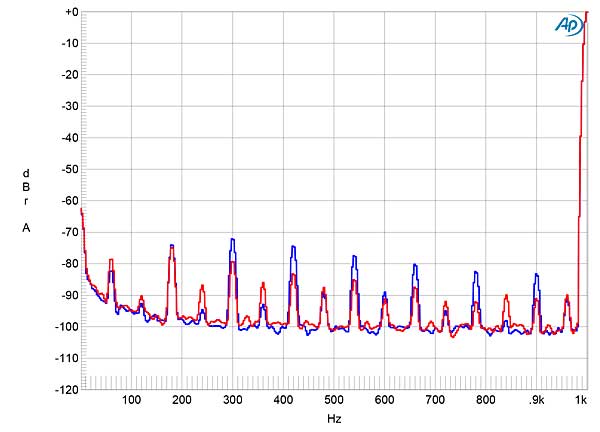
Mark Levinson specifies the No.5805 as delivering a maximum power of 125Wpc into 8 ohms (21dBW). At our usual definition of clipping (ie, when the percentage of THD+noise in the amplifier's output reaches 1%), with continuous drive in both channels, the No.5805 exceeded that spec, delivering 133.5Wpc into 8 ohms (21.25dBW, fig.4). With both channels driven into 4 ohms, the amplifier clipped at 210Wpc (20.2dBW, fig.5), and into 2 ohms with one channel driven, it clipped at 370W (19.6dBW, fig.6).
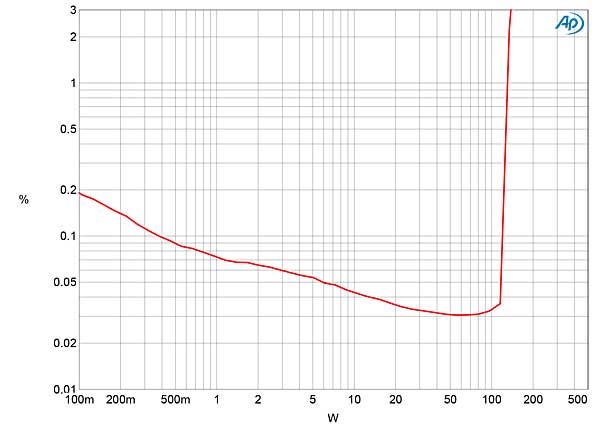


The downward slope of the traces at levels below 50W or so in figs.4 and 5 implies that actual distortion lies beneath the noise floor, so I looked at how the No.5805's THD+N percentage varied with frequency at a level of 20V, which is equivalent to 50W into 8 ohms, 100W into 4 ohms, and 200W into 2 ohms. The distortion levels were low in the bass and midrange in both channels into 8, 4, and 2 ohms (fig.7), and the usual rise at higher frequencies due to the circuit's decreasing open-loop bandwidth was smaller than usual in the left channel (blue, cyan, and gray traces) and nonexistent in the right (red, magenta). The shape of the distortion-spuriae waveform in the right channel (fig.8) suggests that the third harmonic was dominant at low powers, but the second harmonic was actually the highest in level around 4dB below the clipping power (fig.9). High-order intermodulation products resulting from an equal mix of 19kHz and 20kHz tones at 100Wpc peak into 4 ohms were low in level (fig.10), and the second-order difference product lay at just –77dB (0.014%).

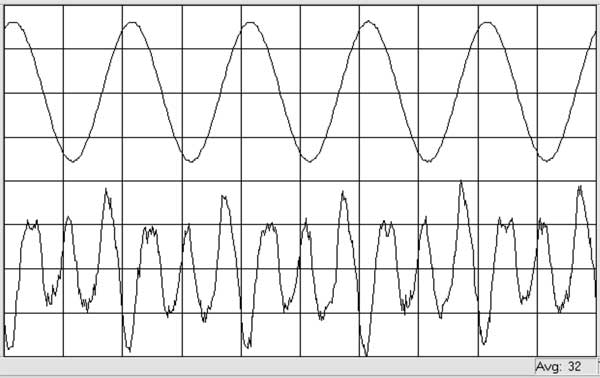
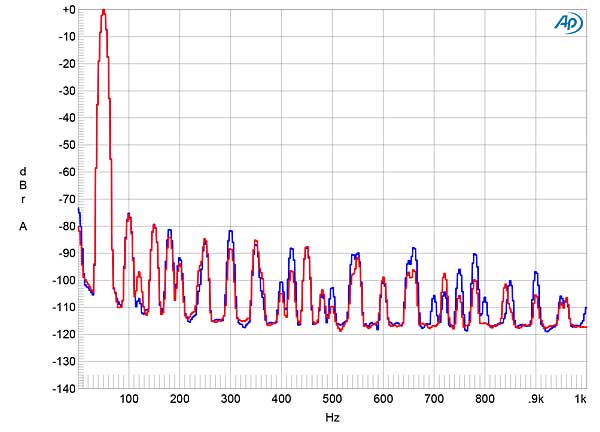

Turning to the No.5805's digital inputs, the optical S/PDIF inputs locked to datastreams with sample rates up to 96kHz, the coaxial input up to 192kHz. All digital inputs preserved absolute polarity. Apple's USB Prober utility identified the No.5805 as "No580x" from "HARMAN" and confirmed that its USB port operated in the optimal isochronous asynchronous mode. The AudioMIDI utility revealed that the USB port could handle 16- and 24-bit integer data at all sample rates up to 384kHz. With the volume control set to its maximum, a 1kHz digital signal at 0dBFS resulted in output levels of 5.6V at the preamp and headphone outputs. A signal at –12dBFS gave rise to 29.4V into 8 ohms at the speaker outputs, which is equivalent to 108W into 8 ohms. As is often the case with integrated amplifiers offering digital inputs, these have around 10dB too much gain compared with the line-level analog inputs. I continued testing the Mark Levinson's digital inputs from the preamplifier outputs with the power amplifier stage turned off using the menu.
The No.5805 offers a choice between seven different reconstruction filters that can be set individually for each digital input: Apodizing Fast, Brickwall, Fast Linear, Fast Minimum, Hybrid Fast, Slow Linear, and Slow Minimum. Looking at each filter's impulse response with 44.1kHz data indicates there are three—Apodizing Fast, Brickwall, and Fast Linear—that all have similar linear-phase time-domain behavior (fig.11). The Slow Linear filter was still linear-phase in nature but with a much lower amount of symmetrical ringing on either side of the single sample at 0dBFS (fig.12). The Fast Minimum filter was, as its name suggests, a minimum-phase type, with all the ringing following the single high sample (fig.13), while the Slow Minimum filter had less ringing (fig.14). The Hybrid Fast filter had a small amount of ringing before the high sample and more after (fig.15). In this respect, it appears identical to the Hybrid filter used in Pro-Ject's Pre Box S2 Digital processor (footnote 1), which I preferred when I auditioned that DAC.

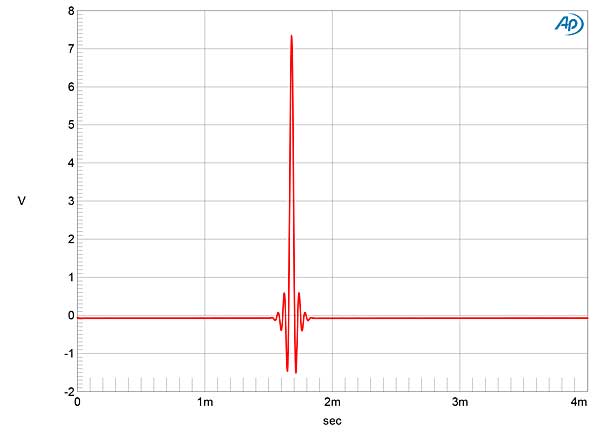



With 44.1kHz-sampled white noise, the Apodizing Fast, Brickwall, and Hybrid Fast filters all rolled off rapidly above the audioband, reaching full stop-band suppression at half the sample rate (fig.16, red and magenta traces). With the Fast Linear and Fast Minimum filters, full stop-band attenuation was reached at 24kHz, with the aliased image at 25kHz of a full-scale tone at 19.1kHz suppressed by almost 110dB (fig.17). The Slow Linear and Slow Minimum filters behaved similarly in the frequency domain, with a slow rolloff above 20kHz with 44.1kHz-sampled white noise (fig.18, red and magenta traces) and the aliased 25kHz image (blue and cyan traces) suppressed by 23dB. The harmonics of this tone, however, were all extremely low in level.
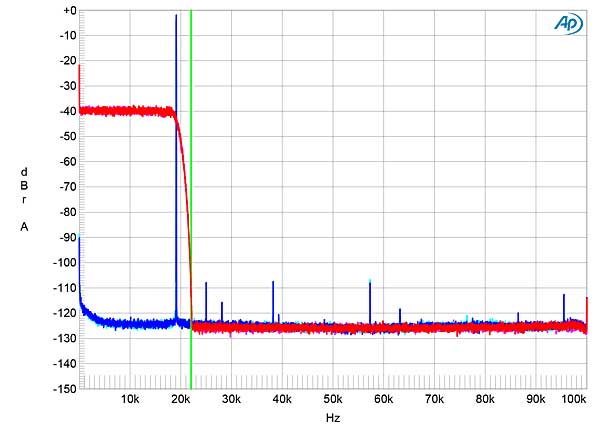
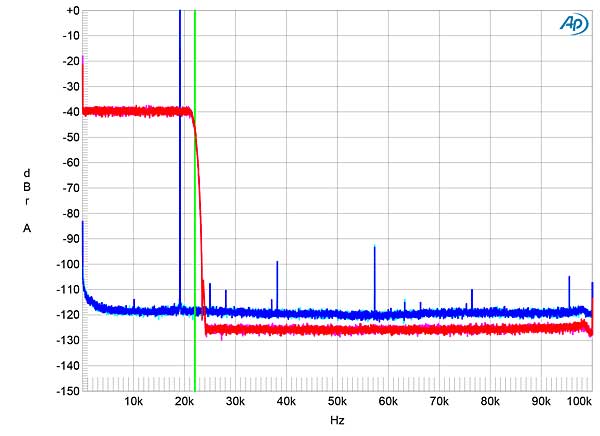

The Mark Levinson's digital frequency response with the two Slow filters and with data sampled at 44.1, 96, and 192kHz follows the same basic shape at each sample rate, with a sharp rolloff above 17kHz with 44.1kHz data (fig.19, green and gray traces). The response with 44.1kHz data with the Fast filters extended to 20kHz (not shown). Channel separation for the digital inputs measured at the preamplifier outputs was superb, at 120dB at and below 1kHz. When I increased the bit depth from 16 to 24 with a dithered 1kHz tone at –90dBFS (fig.20), the noise floor dropped by about 12dB in the top two audio octaves, meaning that the No.5805 offers around 18 bits' worth of resolution in this region, though a little less in the bass and midrange. With undithered data representing a tone at exactly –90.31dBFS (fig.21), the three DC voltage levels described by the data were well resolved and the waveform was symmetrical, though some HF noise was present. With undithered 24-bit data, the result was a slightly noisy sinewave (fig.22).
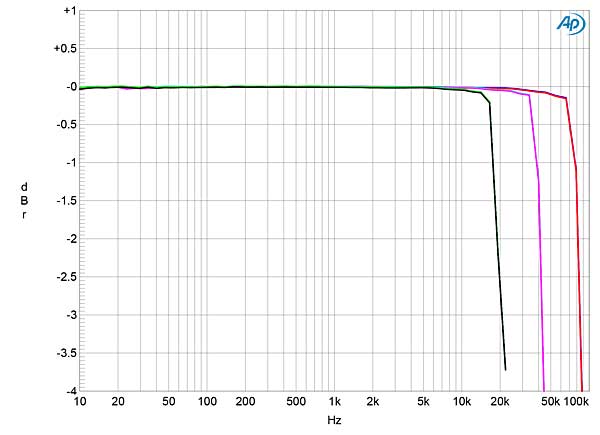
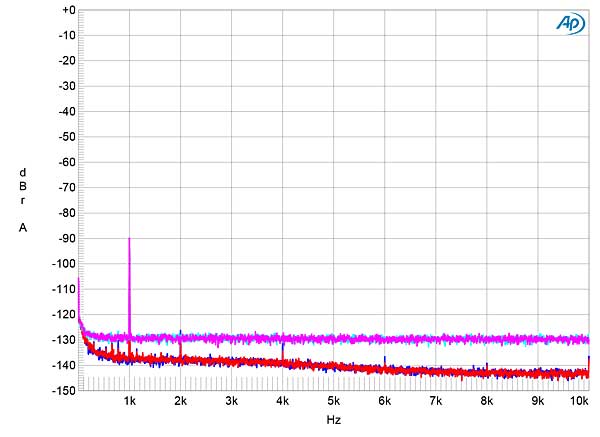


Intermodulation distortion via the No.5805's digital inputs was extraordinarily low, the difference product at 1kHz with a full-scale mix of 19kHz and 20kHz tones lying at –110dB (0.0003%, fig.23). This graph was taken with the Fast Linear filter. The 1kHz product was even lower in level with the Slow filters, but, as expected, the aliased images of the primary tones were only suppressed by 20dB or so (fig.24). When I tested the digital inputs' rejection of word-clock jitter with 16-bit J-Test data, the odd-order harmonics of the LSB-level, low-frequency squarewave were all at the correct levels (fig.25, sloping green line). However, three spurious tones can be seen, these having frequencies of 9.38kHz, 9.61kHz, and 9.89kHz. I have no idea where these tones arise from, and they were present with all digital inputs and with 24-bit data (fig.26). However, as they lie around –110dB, I doubt they will have audible consequences.




To examine the MM and MC phono inputs' performance behavior, I floated the signal generator's outputs and ran a separate ground connection from the binding post next to the amplifier's phono input RCAs, which gave the lowest level of noise. For the MC input, I set the appropriate DIP switch for each channel to its Ground position. With the volume control at its maximum setting, the MM input's voltage gain at 1kHz measured 48.1dB from the preamplifier and headphone outputs and 74.5dB from the speaker outputs. The MC's gain, measured at the preamplifier outputs, was a very high 77.8dB. All three outputs preserved absolute polarity with both MM and MC phono input signals. The MM input impedance was 54k ohms at 20Hz, 49k ohms, and 41k ohms at 20kHz, these impedances appropriate for MM cartridges. With the MC input's impedance set to 1000 ohms, I measured an impedance of 770 ohms. With it set to 37 ohms, which I understood to be Jim Austin's preference, it measured exactly 37 ohms.
The phono-stage RIAA error was very low in the treble and midrange, and precisely matched between channels, but featured a 0.6dB plateau in the bass (fig.27). With the phono inputs shorted to ground and the volume control set to "80," the MM input's wideband, unweighted signal/noise ratio (ref. 1kHz input signal at 5mV and measured at the preamp outputs) measured a good 64dB in both channels. An A-weighting filter increased the ratios to an excellent 82.5dB. The MC input's unweighted, wideband S/N ratios were even better, at 70dB in the left channel, 67.5dB in the right, both ref. 1kHz at 5007#181;V. These ratios increased to 82.8dB and 80.8dB, respectively. The No.5805's phono preamplifier inputs are very quiet.

The MM input's overload margins were good across the audioband at just over 17dB. However, and perhaps due to the MC input's higher-than-usual gain, the overload margins for this input measured a low 7.6dB from 20Hz to 20kHz, which suggests that this input is optimized for low-output moving-coil cartridges. Both harmonic distortion (fig.28) and intermodulation distortion (fig.29), measured with the MM input at +12dB ref. 1kHz at 5mV, were very low in level.
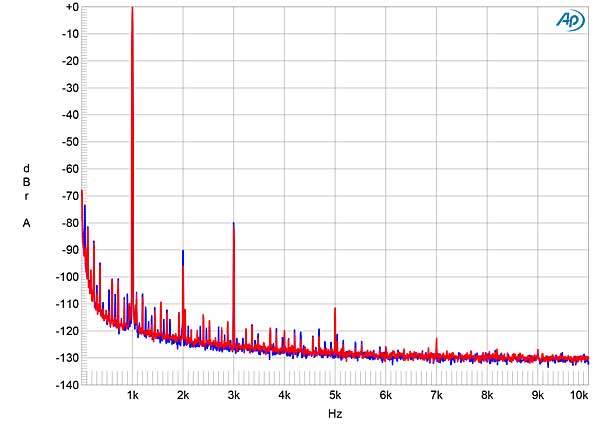

Overall, Mark Levinson's No.5805 offers excellent measured performance.—John Atkinson

So, how does the sound compare to the 585? One can now occasionally find a used 585 for a similar price.

If you already have or, in the market for under $5,000 speakers, Outlaw Audio RR2160, which was reviewed by Stereophile may be a good choice :-) ...........

"That said, the Levinson No.5805 is cheaper than just about everything else in its class."
Really? The NAD M32, at half the price, offers more power, a DAC with higher resolution (20 bits versus 18) and lots of functionality. I'd choose the NAD (I did).

... measured continuous power output as the M-L No.5805, plus it includes streaming capability and a room correction function - all for only $750.
https://usa.yamaha.com/products/audio_visual/hifi_components/r-n803/index.html
https://www.eisa.eu/awards/yamaha-r-n803d/
https://audio.com.pl/testy/stereo/amplitunery-stereo/2984-yamaha-r-n803d
The amplifier/DAC section is similar to that of the A-S801 integrated amp about which a TAS reviewer said:
"The Yamaha A-S801 looks good, sounds splendid, and has a long list of useful features at a price that makes it a flaming bargain! I suspect many readers are lifelong audiophiles like me, for whom system upgrades are a way of life, possibly even the purpose of life. But for lots of people who just want a good hi-fi to play their music on, a hi-fi may be a once-in-a-lifetime purchase. For those people, or for anyone who wants good sound with lots of flexibility at a reasonable price, the Yamaha A-S801 integrated amplifier would be my top recommendation. It may be the only hi-fi electronics purchase they will ever need."

... then what isn’t?
It is expensive, but still offers a lot of THD per buck. :) Are they trying to emulate tube amps with solid state technology? If so, they are getting close.

If ML was still owned by Madrigal this unit would probably cost $20K (but I think the performance would have been much better).

Yeah, that's quite a stretch to call this level of technical performance "excellent". Across the board we see measured results and FFT's with rather middling (eg. J-Test with spurious tones) if not poor (eg. >0.1% THD+N at 1W into 4-ohms!?) results.
$8500 is certainly not cheap at this level of performance even though it does have quite a number of features as an integrated amp.

Although it has less number of features than 5805, it would be interesting to see a comparison review between 5805 and the new Krell K-300i integrated amps :-) ...........

Don't worry, be happy with the PS audio Sprout and the ELAC speakers for $899 :-) ..........

The above combo is available from PS Audio :-) ........

"One could argue, though, that Levinson's new No.5805 integrated amplifier ($8500 with DAC and phono stage) is a budget component"
But one would be wrong.

Wryly amused by Mr Austin's comment about a waterfront cottage in the Keys with a flatsboat outback...New skiffs can easily run 6-10 times the cost of this integrated amp. A "cottage" in the Keys, more likely to be a mobile home on a canal and run you a quarter million.
Plus ungodly insurance. Dogs are still cheap tho....
Worth every penny when you get that first permit on fly.Especially when your dog is with you and says "good job,Ralph". Even tho your name isn't Ralph.


I am not sure if you would know, but is this amplifier circuit the same as the one used in Crown amplifiers?
They seem so similar, but I am not technically informed enough to know. (The brands have the same owners, so I wonder.)

Most of the Crown amps are now Class-D amps, as far as I know ........ ML amps are Class-AB ....... In the (good) old days ML made lot of Class-A amps :-) ........
ML top model No.53 is some type of Class-D :-) ........

Crown says...
"DriveCore's front-end drive circuits leverage the inherent efficiency of Class D output stages while also maintaining superb sonic characteristics. The end result is an ultra-efficient one-piece audio amplifier circuit that exhibits the exemplary audio quality of a highly evolved Class AB design."
I don't know if you could also call it class AB, or not!

JA1 is lot more qualified to answer your question :-) ........

So, Crown may be an 'I'ntelligently 'D'esigned Class-ID :-) ........

Stereophile reviewed Crown Macro Reference power amp ......... It was a power house with impressive measurements :-) ........


Wow, I'm in the camp with the people that don't think that $8.5K is a budget component and that this box's measured performance is not exemplary.
You can buy a really nice phono pre-amp, a Benchmark DAC3 HGC and AHB-2 amp that will blow this away for the same price or less.
Another example of underachieving equipment getting a glowing review on this site.

Another example of underachieving equipment getting a glowing review on this site.Have you heard it? Jim Austin, Editor Stereophile

ML5805 is capable of driving 2 Ohm loads ....... See measurements ........ Lot of integrated amps have hard time driving that kind of low impedance loads :-) ........
ML5805 won't lose the 'grip', so to speak :-) .........

ML5805 may work well with the Revel Performa F228Be loudspeakers ($10,000/pair) ........ Stereophile Class-A :-) .........

What’s with the signal to noise ratio measurement in the 60-dB range? Possibly a typo? Otherwise I would have expected to see a comment like “resulted in a disappointing 67.9 dB” rather than a statement to justify the result. That number does not seem like excellent measured performance for an $8,500 integrated amplifier by an esteemed company such as Mark Levinson.